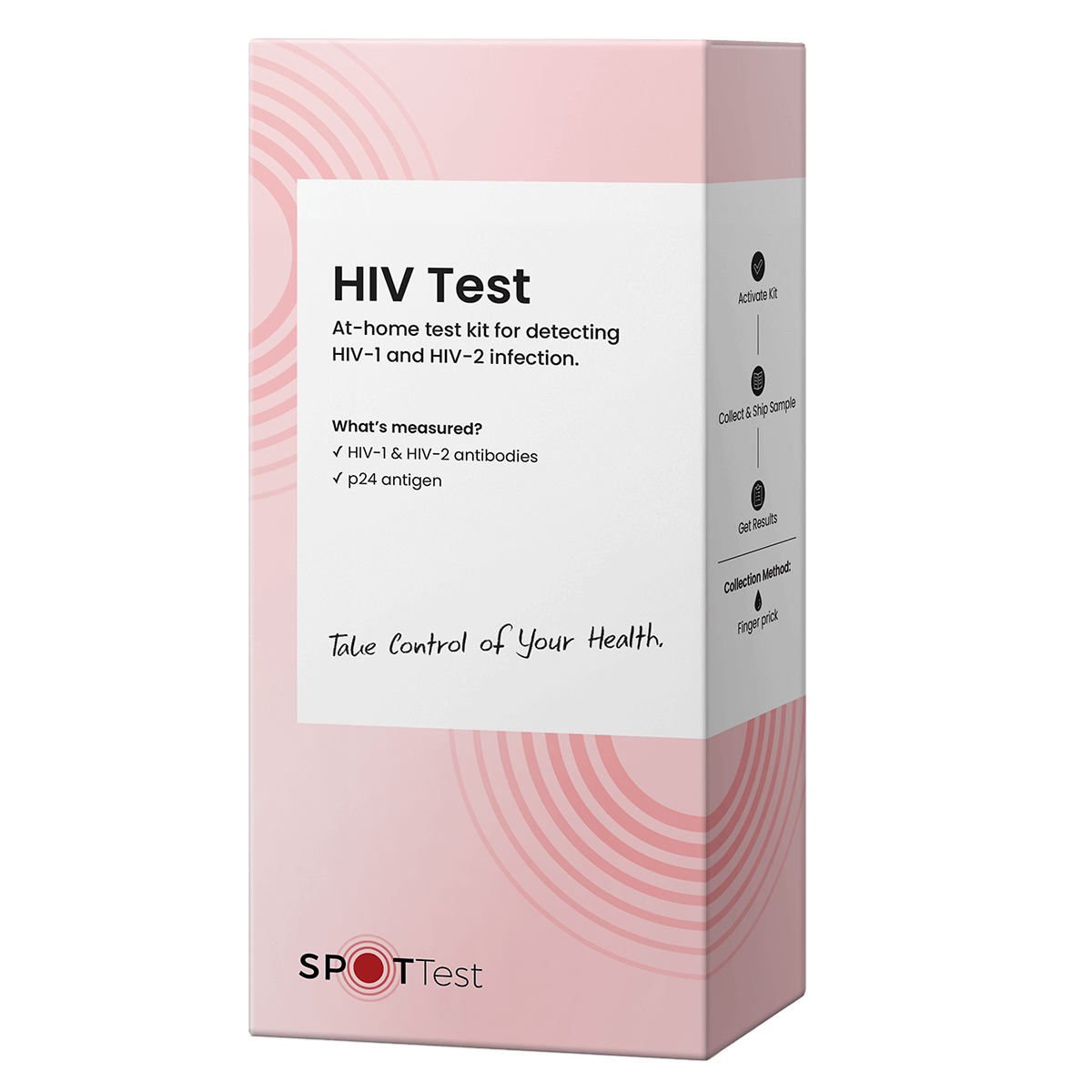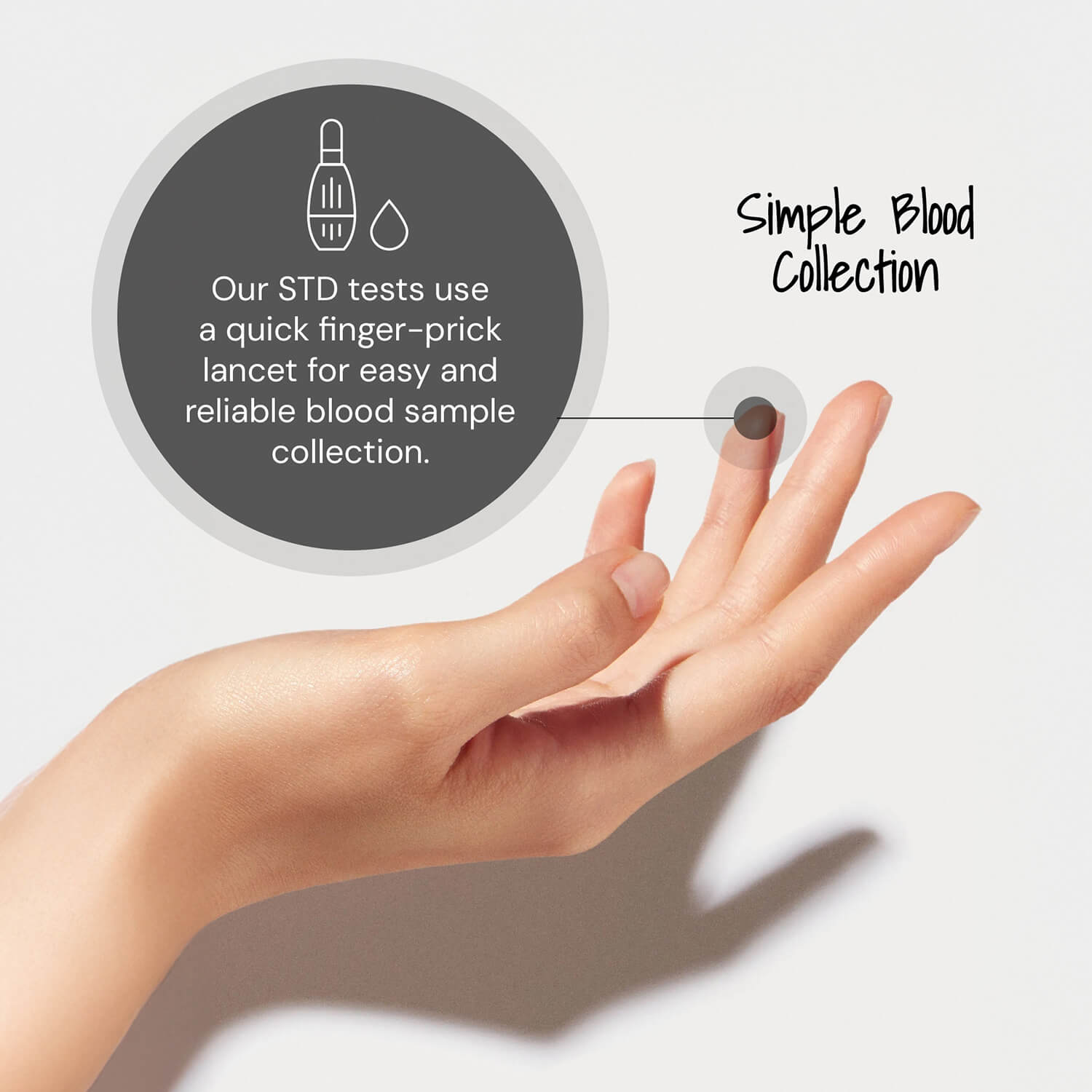HIV Test
Human immunodeficiency virus (HIV) is a blood-borne virus that spreads through contact or transfer of blood, semen, pre-ejaculate, and vaginal fluids. This 4th generation at-home STD test is the most advanced test to accurately detect an HIV infection.
Measures:
✓ HIV IgG antibodies & p24 antigen
✓ HIV-1 & HIV-2
Collection methods:
Finger Prick Blood
$69.00 Original price was: $69.00.$49.00Current price is: $49.00.
- Highest accuracy
- Discreet shipping
- Results in 1-3 days*
- Highest accuracy
- Discreet
- Results in 1-3 business days
Take charge of your health and safeguard others—get tested for HIV today.
Human immunodeficiency virus (HIV) is a sexually transmitted disease that spreads through contact with blood, semen, pre-ejaculate, and vaginal fluids. It can also be transmitted from an infected mother to her infant during pregnancy, childbirth, or through breastmilk.
HIV attacks immune system cells, and without effective treatment, it can lead to a weakened immune system and the development of acquired immunodeficiency syndrome (AIDS).
While there is no cure for HIV, antiretroviral therapy (ART) is highly effective in preventing transmission and stopping the progression to AIDS. Post-exposure prophylaxis (PEP) is also available as an emergency treatment to reduce the risk of infection after potential exposure.

Why take this test?
The CDC advises that everyone aged 13 to 64 should undergo HIV testing at least once as part of routine healthcare.
People in higher-risk groups, such as men who have sex with men, injection drug users, and sex workers, are encouraged to get tested annually.
HIV screening is also recommended as part of the routine prenatal testing panel for all pregnant women to ensure early detection and care.
This 4th-generation HIV test offers improved accuracy and the ability to detect HIV at an earlier stage compared to older rapid tests.
If you suspect recent exposure to HIV, it’s important to understand the “window period,” which is the 18-45 days it may take for HIV antigens and antibodies to become detectable. Immediate testing is recommended (though results may be negative within the first two weeks), followed by additional testing at six weeks, three months, and six months.
HIV SYMPTOMS
Acute Stage
Swollen lymph nodes
Weight loss
High fever
Diarrhea
Muscle aches
Clinical Latency Stage
AIDS
Extreme fatigue
Pneumonia
Depression
Memory loss
Skin discoloration
Rapid weight loss
Increased susceptibility to infections
What's included in this test?
Antigens are foreign substances that trigger an immune response. The HIV p24 antigen, a core protein of the virus, is typically detectable in the blood within 2–3 weeks of exposure. This makes it a valuable marker for diagnosing HIV during the early stages of infection.
As the immune system responds to the virus, antibodies against the p24 antigen are produced, leading to a decline in detectable p24 antigen levels approximately 40–45 days after exposure. Therefore, relying solely on p24 antigen detection is not effective beyond the early stages of infection.
The 4th generation HIV test used here improves reliability by detecting both the p24 antigen and antibodies to HIV-1 and HIV-2, enabling accurate diagnosis across different stages of infection.
When a person is infected with HIV, their immune system generates antibodies specific to the virus. These antibodies typically become detectable in the blood 23–90 days after exposure and remain present for life (in the case of IgG antibodies).
HIV tests that detect only antibodies, such as rapid HIV tests, have a prolonged “window period” of up to three months after exposure. During this time, an individual may be infected and capable of transmitting the virus while still testing negative for HIV.
The 4th generation HIV test addresses this limitation by detecting both HIV antibodies and the p24 antigen, which appears earlier in the infection process. This significantly reduces the “window period” to just 18–45 days post-exposure, allowing for earlier and more accurate detection.
How It Works


CHOOSE TEST
Select your test from our wide selection of home test kit options. Receive your kit within a few days in a discreet unmarked package.

COLLECT SAMPLE
Collect your sample quickly and discreetly from the privacy of your own home. No appointments or lab visits required.

GET YOUR RESULTS
Get your physician reviewed results in a secure online portal in 1-2 days. Free telehealth consult provided if required.

FAQs
For more, visit our Learning Center

Our lab employs an automated antigen/antibody combination test to detect the HIV p24 antigen and antibodies to HIV-1 and HIV-2 in a finger prick blood sample. The p24 antigen typically appears within 2-3 weeks after exposure, while HIV antibodies are usually detectable 4-6 weeks post-exposure.
If your test result is positive, reach out to a healthcare professional right away to begin treatment. Follow their treatment plan and notify your sexual partners so they can get tested and treated if needed.
HIV is managed with a lifelong regimen of antiretroviral therapy (ART), which involves taking a combination of HIV medications daily. While ART does not cure HIV, it can greatly reduce the virus’s impact on the body and prevent its transmission. It’s essential for individuals living with HIV to follow their treatment plan consistently and attend regular medical check-ups to monitor their health. Early diagnosis and strict adherence to treatment are crucial for effectively managing HIV.
HIV infections are usually diagnosed by detecting HIV antigens and antibodies in a blood sample.
The HIV p24 antigen, a structural component of the virus, can typically be detected 2-3 weeks after infection. It peaks early and then decreases to undetectable levels as the body begins to produce antibodies.
HIV antibodies, produced by the body in response to infection, are generally detectable 4-6 weeks after exposure. Once they appear, they usually remain detectable indefinitely, allowing for long-term identification of HIV infection.
Preventing HIV involves a combination of safe practices and medical interventions. Here are some steps you can take to reduce your risk:
- Practice Abstinence: The surest way to prevent these STDs is to abstain from or delay sexual activity.
- Get Regularly Tested: Know your HIV status and that of your partners. Regular testing is especially important if you have multiple partners or engage in high-risk behaviors. Early detection through tests can lead to timely treatment.
- Use Condoms Correctly: Condoms are very effective in reducing the risk of HIV transmission when used properly during every sexual encounter.
- Limit Sexual Partners: Reducing the number of sexual partners decreases the risk of HIV exposure.
- Mutual Monogamy: Being in a mutually monogamous relationship where both partners have been tested and know their HIV status can significantly reduce risk.
- Pre-exposure Prophylaxis (PrEP): If you are at high risk for HIV, PrEP is a daily medication that can greatly reduce your risk of HIV infection.
- Post-exposure Prophylaxis (PEP): If you think you’ve been exposed to HIV within the last 72 hours, PEP can reduce your risk of becoming HIV-positive.
- Avoid Sharing Needles: If you inject drugs, use only sterile injection equipment and water, and never share your equipment with others.
HIV remains a major public health issue in the United States. According to the CDC, there were approximately 32,100 new HIV infections in 2021. The majority of new HIV diagnoses (67% or 24,107 cases) were among men who have sex with men, while heterosexual contact accounted for 22% (8,059 cases) of new infections. By the end of 2021, an estimated 1.2 million people in the U.S. were living with HIV, and about 87% of them were aware of their status.





